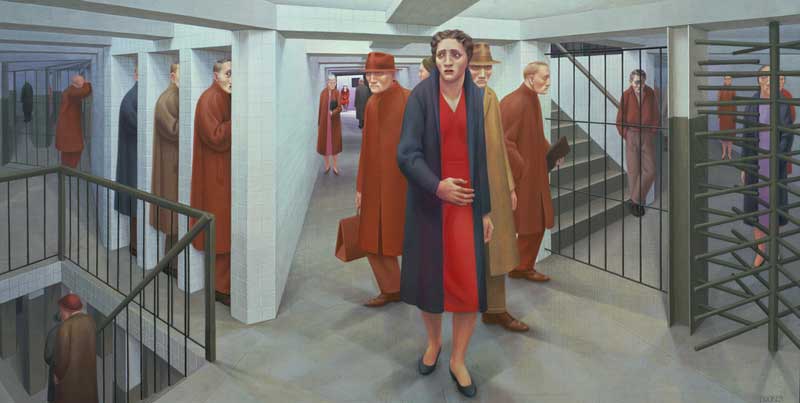 Born on August 5, 1920, in Brooklyn, New York, George Clair Tooker Jr. grew up in suburban Bellport, Long Island and took painting lessons from a family friend as a child. Tooker graduated from Harvard University in 1942 where he studied English Literature and continued to pursue his interest in art.
Born on August 5, 1920, in Brooklyn, New York, George Clair Tooker Jr. grew up in suburban Bellport, Long Island and took painting lessons from a family friend as a child. Tooker graduated from Harvard University in 1942 where he studied English Literature and continued to pursue his interest in art.
Tooker was discharged from officer training school in the U.S. Marines during World War II due to illness brought on by stress. In 1943, he enrolled in the Art Students League in New York and studied under leading social realist painters Reginald Marsh and Kenneth Hayes Miller. Tooker was introduced to the medium of egg tempera by painter Paul Cadmus, with whom he spent six months together traveling and studying art in Italy and France in 1949. In 1949, Tooker also met painter William Christopher, who became his lifelong companion.
In 1950, Tooker began to earn both recognition and income from his art and in 1953, the Whitney Museum bought his best-known painting, The Subway. Further recognition followed, beginning with a solo exhibition at a New York gallery in 1951; followed by four more solo shows and numerous group exhibitions.
“Working on wood panels or Masonite board, Tooker painstakingly built luminous matte surfaces, inch by square inch; soft, powdery colors complemented the rounded forms and fabrics of the paintings.” His early work depicted social and public issues, and stresses the loneliness and alienation of modern urban existence. In the 1970s, the Tooker began to explore more personal states of being expressed in symbolic imagery, often drawn from the bible, mythology, and classic literature.
Tooker’s works have been associated with the Magic Realism and Social Realism movements but he resisted attempts to define his works as such. “I am after reality — painting impressed on the mind so hard that it recurs as a dream,” he said, “but I am not after dreams as such, or fantasy.”
In 1960, Tooker and Christopher moved to Vermont, where they had a weekend home. Tooker taught at the Art Students League between 1965 and 1968, and they spent winters on the Mediterranean coast of Spain as Christopher’s health declined. Tooker returned to Vermont, in 1973 after Christopher’s death.
“In the 1970s, the Tooker began to explore more personal states of being expressed in symbolic imagery, often drawn from the bible, mythology, and classic literature. Tooker, though greatly respected, remained apart from the modernist trends that dominated American art for much of the second half of the twentieth century.”
In 2007, Tooker was awarded the National Medal of Arts – the highest award given to artists and arts patrons by the United States Government.
George Tooker died on March 27, 2011 at his home in Hartland, Vermont. He was 90 years old.
Sources: New York Times, Terra Foundation
Post inspired by David Platt
SOURCE: Daily Art Fixx – Art Blog: Modern Art, Art History, Painting, Illustration, Photography, Sculpture – Read entire story here.
Tags: art










